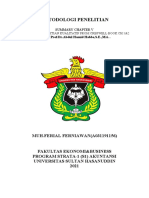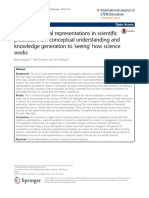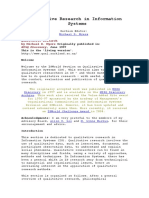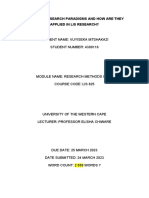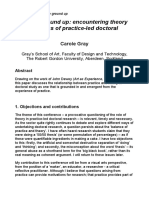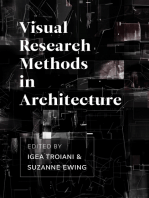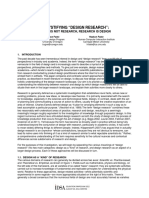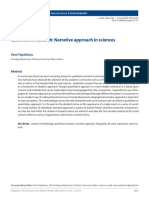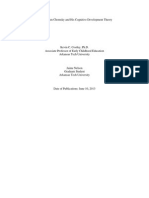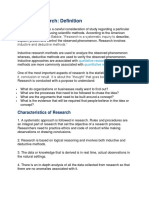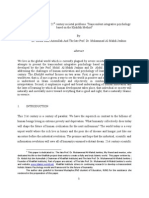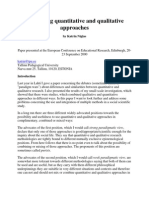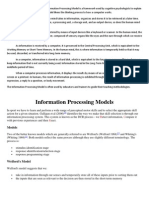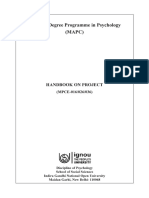Professional Documents
Culture Documents
Implementing The Bricolage: Investigating With Varied Methods
Original Title
Copyright
Available Formats
Share this document
Did you find this document useful?
Is this content inappropriate?
Report this DocumentCopyright:
Available Formats
Implementing The Bricolage: Investigating With Varied Methods
Copyright:
Available Formats
Volume 4, Issue 4, April – 2019 International Journal of Innovative Science and Research Technology
ISSN No:-2456-2165
Implementing the Bricolage: Investigating with Varied
Methods
Dedy Setiawan
English Department - Politeknik Negeri Bandung, Indonesia
Abstract:-Bricolage is an emerging concept of research challenge to researchers which is not bound by rigid, orthodox
methodology which applies all appropriate techniques of methods developed outside the inquiry demands. In another
investigation into a research. This eclectic method is instance, Kincheloe (2004) states that bricolage sees research
intended to have a unified and comprehensive research methods actively rather than passively. This means that we
result. This paper discusses my experience in actively construct our research methods from the tools at hand
implementing the bricolage principle in the research that I rather than passively receiving the ‘correct’ universally
conducted on workplace English in Indonesia. The case applicable methodologies.
study with four sub-cases in my research has undoubtedly
been achieved with satisfying result thanks to the use of Hence, through use of bricolage, Kincheloe (2004) seeks to
bricolage. All the steps taken in conducting the research is comprehend the research context by using earlier experience
described and a number of research methods used and research methods that are suitable to that context.
together with their underlying principles is also
expounded. This article will be useful for those who are According to Denzin & Lincoln (2011) the researcher
undertaking research especially in the methodology part. conducting qualitative research may be seen as a ‘bricoleur’.
Further idea on the functional Inductive Data Reduction They designate that there are many kinds of bricoleurs:
(IDR) is also discussed. interpretive, narrative, theoretical, and political. Furthermore,
they affirm that the qualitative researcher who uses montage is
Keywords: Bricolage, Eclectic Method, IDR Analysis, similar to a quilt maker or a jazz improviser: the quilter
Comprehensive Research stitches, edits, and puts slices or reality together.
I. INTRODUCTION My study employs semi-structured interviews – part of an
ethnographic method as the main inquiry – together with
The Oxford dictionary describes bricolage as multi-research methods: textual analysis, inductive data
‘construction or creation from a diverse range of available reduction (IDR), survey research, hermeneutics,
things’. It is initially from a French word which existed in phenomenology and auto-ethnography. Thus, an elective
mid-twentieth century. As a French word, bricolage comes method – bricolage and being a ‘bricoleur’ – has been
from bricoleur which means someone who ‘does odd jobs and implemented in order to obtain the best possible outcome for
who undertakes repair’ (Oxford Dict, 2013). This is the study.
established by the English-French translator (Linguistics
2013) which explains ‘bricoleur’ as to mean: (in house) to do B. Mixed Methods
odd jobs, potter about; (with cars) tinker about; to knock up There is now a trend to incorporate the two methods -
(infml), and to cobble together. For my study, I take the quantitative and qualitative - in the so called ‘mixed methods’,
definition of bricolage as ‘put together what is available and but the mixed methods approach to research is an extension
around to produce a unified research result’. rather than a replacement for the quantitative and qualitative
approaches to research. The two research approaches will
A. Bricolage as a Method of Inquiry carry on to be useful and important. It is based on the principle
The research definitely applies the principle of bricolage that both methodologies share the same intention of assisting
in the collecting and processing of data. Steinberg (2012) in finding the answers to a set of research questions. Williams
asserts principle of bricolage as an eclectic method by which (2007) asserts that the goal for researchers incorporating the
an educational researcher conducts a study – attributing, in mixed methods approach is to draw from the strengths and to
particular, the earlier work of disciplines and traditions. minimise the weaknesses.
Steinberg (2012, p. 184) affirms that the eclectic method as
such as being: Williams (2007) argues that the quantitative method
pragmatic and strategic, demanding self-consciousness offers an objective measure of reality, while the qualitative
and awareness of the context from the researcher. method allocates the researcher to explore and better
understand the complexity of a phenomenon. Additionally,
Furthermore, Verjans (2005) sees bricolage as a way of Denzin & Lincoln (2011) advises that qualitative researchers
life, while Tshabangu (2009) views the use of bricolage as of a study things in their natural settings.
IJISRT19AP182 www.ijisrt.com 385
Volume 4, Issue 4, April – 2019 International Journal of Innovative Science and Research Technology
ISSN No:-2456-2165
In addition, Denzin & Lincoln (2011) put forwards that B. Auto-Ethnography
all qualitative researchers are philosophers, in a universal Auto-ethnography is a research method that takes
sense: they are guided by highly abstract principles which advantage of the researcher’s own experiences as ethnographic
merge beliefs about ontology– What kind of being is a human data (Maréchal 2010; Southerton 2011). Furthermore, Ellis
being? What is the nature of reality?; epistemology – What is and Bochner (2011) propose that auto-ethnography is a
the relationship between inquirer and the known?; and process that derived from the ‘crisis of confidence’ stimulated
methodology – How do we know the world or gain its by postmodernism in the 1980s: it merges the characteristics
knowledge? of autobiography and ethnography. Ellis and Bochner (2011)
also state that in writing ethnography, the author describes
II. IMPACT OF CONSTRUCTIVISM ON THE STUDY about past experiences. The author is also permitted to reflect
on their own experience, to unite this with interviews as well
The psychological theory behind my research is as supported with descriptions such as photographs, journals
constructivism. The concept of ‘constructivism’, as established and recordings to help with recall.
by Piaget, is based on the belief that every human being is
furnished with a knowledge-building capacity. It is, as In my study I used my personal experience as an
described by Schunk (2008) ‘formed inside people and employee in some organisations where I could have access
learning happens through interactions’. This is reinforced by data resourced from observation, interview, materials and other
Glasersfeld (1990) who points out that the human knower can sources. My experience which helps reinforce the analysis for
obtain some knowledge of a truly existing world and can my thesis embracing my work with the Save the Children
implement this knowledge to modify it. foundation as and with the Australian-based Sagric and other
Indonesian local companies.
Problem-solving is often confronted by employees in
their workplaces and Billett (1996) spreads the view that ‘a C. Naturalism
constructivist view of learning emphasises problem-solving as Observation of first-hand experience is the key factor
a means to construct, organise, index and extend knowledge’. normally found in the definition above. This is because
Similarly, Kerka (2011) asserts that constructivism, as ethnography is placed within the approach of naturalism
contrasting to behaviourism, should trigger the theory of (Angrosino 2007; Kusenbach 2003; Pole & Morrison, 2003;
English for Academic Purposes; the latter simply advocates Sangasubana, 2011; Williams, 2007) and naturalism is dealt
knowledge for behavioural control and task completion by with the setting and location within which social action is
students. Constructivism is in accordance with qualitative formed and experienced.
research which emphasizes on the participants in the regular
everyday world (natural settings) (Croker 2009). Concerning the time taken to caarry out research with
naturalism approach, Sangasubana (2011) proposes that the
A. Ethnograph observation and the extent of the researcher’s participation with
Ethnography is defined by Pole and Morrison (2003, p. the subjects under investigation may require a relatively long
16) as an approach to social research based on the first-hand period of time. Johnson (2009), for example, expended three
experience of social action within a discrete location, in which years of data collection to research a language policy -
the objective is to collect data which will convey the associating micro-level educational practices with macro-level
subjective reality of the lived experience of those who inhabit language policies and discourse. Troman and Jeffrey (2007)
that location. spent three years carrying out a collaborative ethnographic
study of how occupants in five urban neighbourhoods in
Another definition by Silverman (1997) suggests that Hollywood perceive local problems, and how their daily
ethnography is defined as hybrid approach featured by two activities and social exchanges relate to those understandings.
demands on researchers: one observing a setting and gathering Quinlan (2008) spent several months conducting an
data; the other directly concerned in the setting under study, institutional ethnography study using ‘shadowing’, i.e., being
comprising the researchers, as themselves objects of inquiry. present with subjects for lengthy periods of time on a fixed
These two definitions are akin to that of Donan (1997), who basis, as the main method of observation for data collection.
advises that ethnographic research is a type of study which is
based on observation of human action, discourse, and self- Another characteristics which is commonly proposed by
perception, and is anticipated as an proper form of research some scholars regarding ethnography is in the application of
when experimental research is unfitting, and when exactitude is various methods of data collection as well as observation
not required. which comprises interview, site documents and other backup
sources especially meant for triangulation (Angrosino 2007;
Freebody 2003; Pole & Morrison 2003; Sangasubana 2011;
Williams 2007).
IJISRT19AP182 www.ijisrt.com 386
Volume 4, Issue 4, April – 2019 International Journal of Innovative Science and Research Technology
ISSN No:-2456-2165
D. Triangulation of knowledge that is attained by having experience as the
Triangulation is the usage of more than one approach in subject of the study, but fails to intricate further the differences
one study for the sake of enhancing confidence in the findings. between the two approaches.
Denzin (1989) further expounds four types of triangulation, From the research of Barnard, et al (1999) I have observed the
namely data triangulation, investigator triangulation, comparison of phenomenography and phenomenology.The
theoretical triangulation and methodological triangulation. most interesting difference between the two methods is that
while phenomenography puts emphasis on collective meaning,
For the purposes of triangulation, quantitative methods phenomenology focuses on individual experience. On this
containing statistical calculation from a survey tool, for basis, I categorise my research as being a phenomenological
example, are also allowed in ethnography as is advocated by study that pursues the knowledge of individuals concerning
Pole and Morrison (20030 their use of English in the workplaces.
A further example provided by Stake (2006) who In terms of theory building based about lived experiences,
suggests that triangulation can be used to gain assurance from a Goulding (2005) advocates that phenomenology has its own
diversity of sources. In a multi-case study, or a case study unique characteristics and philosophy. He contends that this is
consisting of many sub-cases, the researcher is confronted to both a beneficial and a beneficial approach to understanding
see what is shared across the cases; triangulation will help in how people undergo events or phenomena. Based on
making meaning across these cases. epistemology which perceives knowledge as a social
construction (and not a correspondence with ‘truth’) and a
In addition to interviews as the main source, I used theory that sees learners as active constructors , Pring (2000)
observation, document analysis and survey. Survey is used and Hopwood (2004) claim phenomenology presents itself as a
especially to substantiate the findings in the interview. Both the proper approach for investigating participants, inspecting them
interviews and survey allowed me to see how knowledge and as people who interpret the world and their experiences, and
experience were observed by the subjects under investigation. who construct personal understandings of themselves. This
In this sense, this research also involved a phenomenological suggests that phenomenology has its own unique
approach. characteristics and philosophy.
E. Phenomenology I conclude that a study may be considered as a
Katz and Csordas (2003) describe phonomenology as an phenomenology when it examines an individual’s experience
approach that pursues to reveal the foundation of a culture. and knowledge. Consequently, I consider that this study fits
This definition overlooks reference to experience and precisely with a phenomenological approach.
knowledge, which Lester (1999) advises is a basic foundation
of phenomenology. He declares that phenomenology is dealt III. CASE STUDY
with the study of experience from the individual standpoint,
‘bracketing’ taken-for-granted conventions and usual ways of From the point of view of the subjects under
identifying. In addition, he advocates that the drive of the investigation, the present study can be grouped as a ‘Case
phenomenological approach is to brighten the specific, to Study’. A case study, as suggested by Yin (1994) is an
recognize phenomena by way in which they are observed by empirical study that scrutinizes a contemporary phenomenon
the actors in a situation. Moreover, he states that within its real-life context, particularly when the limitations
epistemologically, phenomenological approaches are between phenomenon and context are not clearly evident’.
grounded on a paradigm of personal knowledge and
subjectivity that underline the importance of individual Taking an alternative position, Stake (2008) distinguishes
perspective and interpretation. three types of case study, namely, ‘intrinsic’, ‘instrumental’
and ‘collective’. Intrinsic case studies occur when a study is
F. Phenomenography conducted because one requests better understanding of a
At this juncture, I need to differentiate between particular case. Whilst, instrumental case studies occur when a
phenomenology and phenomenography. The latter is an particular case is investigated to provide insight into an issue
empirical research tradition that was intended to answer or refinement of theory. Finally, collective case studies happen
questions about thinking and learning, especially for when researchers study a number of cases jointly in order to
educational research. Ornek (2008) proposes that investigate the phenomena, population or general condition.
phenomenography is the empirical study of the diverse ways
in which people think of the world, whereas phenomenology Whether or not generalisation is probable from a
is ‘the study of phenomena’ associated with individual collective case study is a cause for some argument. Stake
perspectives. (1995) asserts that ‘grand generalizations’ can be drawn from a
case study, although he proposes that the real business of case
Ornek (2008) argues that phenomenology and study is ‘particularisation’, not ‘generalisation’ Stake (1995).
phenomenography are comparable in that they are both fields
IJISRT19AP182 www.ijisrt.com 387
Volume 4, Issue 4, April – 2019 International Journal of Innovative Science and Research Technology
ISSN No:-2456-2165
Yin (2003) emphasizes three aspects of the case study Because the nature of semi-structured interview is open to
inquiry: coping with the technically distinctive situation, modification, I can direct ‘spontaneous questions’ to
relying on multiple sources of evidence, and benefiting from participants particularly when I required clarification of, or
the prior development of theoretical propositions. All these further information about the matters concerned. I undertook a
characteristics are accommodated in this study as I have literal transcription of each of the 11 recordings.
developed a case study with four sub cases. This, according to
Yin (2003) permitted me to yield multiple findings using a IV. OBSERVATION
‘replication logic’ from which I can develop and build a theory
through analytical generalisation and comparison of cases. The visits and observations that I made for my research
have given me abundant knowledge on how English is used.
In conclusion, of the three typologies of case study There were some diverse conditions in each company;
suggested by Stake (1995) – ‘intrinsic’, ‘instrumental’ and however, I noted significant similarities in the atmosphere and
‘collective’ – I categorize my study as a ‘collective case study’ culture of the companies. Similarities were found in the
because it consists of four sub-cases which are instrumental in security level necessary in both the multinational and foreign
learning about the use of English in each of four workplaces. public companies. In each, I found that these companies have
In terms of the sites under investigation, the present study is their own system of security. For each, the outcome is the
classified as an ‘ethnographically informed cross-case analysis’ same: it is intended to protect the company and its employees
since four different sites, namely national private, national from outside intruders. The security in the multinational
public, multinational and foreign companies were observed and company was very tight. It was less tight in the foreign
compared. national company. By comparison, security in the state-owned
and private companies was not obvious at all.
A. Instrument Development
In this ethnographic study, a range of instruments was The corporate culture in each company was distinctive.
used for both the alumni workers and their supervisors. The The culture components that engaged me comprised the
main instrument was in the form of questions that I used in the following: the relationship and interaction among workers; the
semi-structured interview sessions. I obtained other supporting physical condition of the buildings with their maintenance; and
data obtained from observations, a survey, journal records and the worker’s performance. None of elements has a direct
personal notes of informal interviews that I preserved for the influence with the area of this study; indirectly, it may have an
period of the four visits. A questionnaire was made and influence in the use of English language in the workplace.
distributed, either in their workplaces or online, to 200
randomly chosen polytechnic graduates. A. Questionnaires Administered to Alumni Workers
I circulated questionnaires to the polytechnic alumni in
B. Semi-Structured Interviews the four companies when I visited. I also asked some other
Interviews are used to gather data because they can alumni to fill out the questionnaires online via the social
provide insights into people’s experiences, beliefs, network. The total number of returns was 36 – a small but
perceptions, and motivations at depth that is not probable with sufficient number for descriptive data analysis.
questionnaires (Richards, 2009). Semi-structured interviews
are used because the interviewer has a clear picture of the The content of the questionnaires was similar to the
topics that need to be covered but is prepared to allow the questions in the interview - it was meant to strengthen the
interviewer to develop unexpected directions. This view is findings of the qualitative analysis. Additional questions were
supported by Nunan (1993) who states that in a semi- added concerning the types of language skills required and the
structured interview, topics and issues rather than questions perceptions of importance of the language skills in their
determine the course of the interview. Open response workplaces.
questionnaire items, as ‘one of the techniques used to collect
qualitative data’ (Croker, 2009) are used as they can produce a The questionnaires and semi-structured interview
wide range of rich and often surprising responses (Browns, questions were pre-tested by similar respondents. In particular,
2009). the pre-test emphasized on ensuring that the items in the
questionnaire were obviously understood and to determine the
Questions for the semi-structured interviews were made estimated time taken to complete it.
in a form of open but guided questions that followed the
principles outlined above. The questions included issues and B. Collection of Data from the Company’s Documents and
items specifically geared towards answering the research Records
questions. I have told the high level of security at Minyak MNC and
Alatbesar FPC. In particular, the prohibition on the taking of
I conducted some limited piloting of the questions. This photographs in the offices of these companies meant that I was
piloting focused on the clarity of the language and instructions ot able to obtain copies of any instructions written in English.
for the semi-structured interviews. One of the workers interviewed clearly signed that the
IJISRT19AP182 www.ijisrt.com 388
Volume 4, Issue 4, April – 2019 International Journal of Innovative Science and Research Technology
ISSN No:-2456-2165
documents made by the company cannot be shown to anybody should be able to interpret whether a particular set of words
as they are confidential. spoken is an independent statement which should be treated as
a single sentence. I also considered both minor (short
I was suggested by the contact person at Alatbesar FPC expressions) and major sentence (complete sentences with a
that I should access their website, all of which is written in subject and predicate) types of sentences to be ‘single
English – a general type of English which is intended for sentences’ (Crystal, 2010).
information – to find out how English is used in the company. I
chose not to follow this suggestion because the English used in Transcription also needs adequate knowledge of
a website is unrelated to the English that would be used in a terminologies or words spoken for the interviewees did not
workplace. spell out every single word spoken. Failure to do this can result
in incomprehensible phrases or words which are meaningless.
However, I was able to collect some documents written in In the thirteen interviews, I found a few words which were not
English as a result of my email correspondence with the certain but then were interpreted according to context such as
company. I could make a judgment of English capability from the abbreviation of TSOC which were thought to be ‘Toyota
the questionnaire responses, for some comments in the Sales Operation’. For the uncertain words as such, I included
questionnaire responses were written in English. As I care the question mark besides the uncertain words or
only about the contents of the comments, I did not see the terminologies.
relation between the quality of English they produced and the
self assessement. I transcribed the original audio-tape recordings of the two
semi-structured interview responses, entering them in a column
V. DATA ANALYSIS headed ‘Comments’ in a MS Excel spread-sheet. I recorded
the identity of each respondent, using a code, in the adjacent
Regarding the areas of applied linguistics, Crocker left-hand column.
(2009) states two which are significant for my research:
language analysis and contexts, and experiences of language Coding
use. Coding, which is found in the first column of each table
resulting from IDR, is made in such a way that it is easy for
As the former is usually dealt with second language me to separate the table when needed or sort the data
acquisition (SLA), this research falls in the second area – according to the grouping that I want to analyse.
contexts and experiences. As Croker (2009) points out, the The first two letters such as FC, SO, MN and PC stand for the
nature of qualitative analysis entails collecting textual data and types of company. FC is for Foreign Company, SO for State-
they are examined using interpretative analysis Owned Company, MN for Multinational and PC for Private
Company. They are all written with capital letters. Next to the
A. Inductive Data Reduction (IDR) Analysis two capital letters are two small letters that represent the
I applied a qualitative method of inductive data reduction interviewees. These are ‘wa’ and ‘wb’ (representing ‘workers’)
(abbreviated as IDR) to analyse the data that I gathered as a and ‘mn’ (representing the ‘manager’).
result of my field work in Indonesia. The data were collected
from 11 semi-structured interviews: four interviews with Translation
individual managers and seven polytechnic alumni working The interviews were conducted in Indonesian so the
within the four companies under study. translation had to be performed. My experience as a freelance
One of the strengths of qualitative methodology is the rich data translator for an wide period of my life meant that it was easy
it possesses (Denzin, & Lincoln, 2011 ) and it has been for me to translate from Indonesian to English. The translation
confirmed in this research. The data are specially related to my that I performed was not a ‘word for word’ translation as
research topic. I did not include expressions of opinion, found in a computer- or Google/Bling-translation. Such
questions or statements from any conversation in the analysis translations may result in the loss of meaning of the translated
of data. words. My translation was a ‘translation of ideas’ comingfrom
statements expressed in sentences: the sense of the language is
B. Procedure of Inductive Data Reduction Analysis retained, thus preserving semantic and stylistic equivalences
In this section, I carry out a complete description of the (Bell 1991).
approach that I took to the IDR approach. The steps
undertaken (see Ling, 2012) were as follows: Classification and Tabulation of Data
The first step of tabulation is putting all of the
Transcription transcribed and translated interviews in a single column; Ling
The nature of spoken language is often full of unfinished (2012) advocates the use of a spread-sheet for this task,
sentences, ungrammatical statements, interjections and especially when the was only less than 20. I made five
intonation. This can be an indicator that the statement is columns in my initial table with the headings: code,
important, surprises or other expressions, the researcher comments, constructs, concepts, topic areas and organising
IJISRT19AP182 www.ijisrt.com 389
Volume 4, Issue 4, April – 2019 International Journal of Innovative Science and Research Technology
ISSN No:-2456-2165
themes. As part of this initial tabulation, I entered the analysis of documents; responses to a questionnaire. Data
comments according to the topics of the interview. from the semi-structured interviews were transcribed,
translated and tabulated and finally analysed using an
I deconstructed the comments into sentences: these inductive data reduction (IDR) approach which involved
represented individual statements regarding a particular topic. analysing, evaluating, synthesising and changing.
As the first part of the inductive data reduction (IDR), I
analysed each individual statement or sentence to produce a REFERENCES
‘construct’ in the adjacent column; this was my perception, in
a reduced form, of the respondent’s comment. Subsequently, I [1]. Angrosino, M. 2007. Angrosino, M. (2007). Doing
used a combined mental process of evaluation and synthesis ethnographic and observational research. Thousand Oaks,
to produce a further reduced statement: the ‘concept’ that I CA: Sage., Thousand Oaks, CA Sage.
believed was being addressed in the original comment to the [2]. Croker, R. A. 2009. An Introduction to Qualitative
construct column. I then sorted the rows alphabetically in Research. In: Heigham, J. & Croker, R. A. (eds.)
accordance with common concepts to create clusters of a ‘topic Qualitative Research in Applied Linguistics. New York:
areas’; a second sorting of the topic areas permitted me to Palgrave Macmillan.
produce a set of ‘organising themes’ – usually four to six in [3]. Crystal, D. 2010. The Camdridge Encyclopedia of
number. The four steps of IDR – each involving the subjective language', New York, Cambridge University Press.
process of induction – led to a progressive reduction of the [4]. Denzin, N. K. 1970. The research act. , Chicago, Aldine.
original comments, by applying increasingly higher order [5]. Denzin, N. K. & Lincoln, Y. S. 2011. Introduction – The
thinking skills (after Bloom (1956) in the sequence analysis, Discipline and Practice of Qualitative Research. In:
evaluation and synthesis, and creating – ultimately ‘creating’ a LINCOLN, N. K. D. A. Y. S. (ed.) Qualitative Research.
new set of emergent themes (Ling 2012). Los Angeles: Sage.
[6]. Donan, L. 1997. Students as Ethnographers. Classroom
VI. CONCLUSION Teachers and Classroom Research, 98 - 107.
[7]. Ellis, C., Adams, T. E. & Bochner, A. P. 2011.
The main data for this study derived from 11 individual Autoethnography: An Overview. Historical Social
semi-structured interviews; other methods – observation, Research 36, 273-290.
surveys and document analysis – were regarded as support [8]. Glasersfeld, E. V. 1990. Chapter 2: An Exposition of
methods which was meant to authenticate the findings from Constructivism: Why Some Like It Radical. Journal for
the interview data. Research in Mathematics Education. Monograph, Vol. 4,
Constructivist Views
This study is also considered as a cross-case analysis of [9]. Hopwood, N. 2004. Research Design and Methods of
four types of companies: one national private; one national Data Collection and Analysis: Researching Students’
public; one foreign; one multi-national. Observation was Conceptions in a Multiple-method Case Study , . Journal
integral to this study and the four types of companies of Geography in Higher Education,, 28, 347–353.
contributed their own sub-case studies. Each sub-case was [10]. Katz, J. & Thomas J. Csordas 2003. Phenomenological
ethnographically informed by informal and formal interviews, ethnography in sociology and anthropology, .
observations. Simple questionnaires were completed at each of Ethnography, 4, 275–288.
the four sites. Ethnography was the main research method. [11]. Kerka, S. 2011. Constructivism, Workplace Learning,
IDR, that enabled the creation of emergent themes, was the And Vocational Education [Online].
main method used for data analysis. Overall, the study http://www.serprofessoruniversitario.pro.br/imprimir.php
involved a qualitative methodology, supported by quantitative ?modulo=9&texto=465 [Accessed 6 April 2011.
data that hold up the main qualitative data. [12]. Kincheloe, J. L. 2004. Introduction: The power of the
bricolage: Expanding research methods. In: Kincheloe, J.
The present research enquiry was directed by a query L. & Berry, K. S. (eds.) Rigour and complexity in
relating to workplace English in Indonesia. Using a educational research: Conceptualizing the bricolage.
predominantly qualitative methodology, the present study Maidenhead: Open University Press. .
employed ethnography as the main approach; I applied other [13]. Kusenbach, M. 2003. Street phenomenology The go-
methods such as phenomenology and naturalism for along as ethnographic research tool, , . Ethnography Vol
rationalising the employment of the individual knowledge and 4 455–485.
experience of correspondents interviewed in the four different [14]. Lester, S. 1999. An introduction to phenomenological
venues. This informed the independent but integral sub-cases. research [Online]. Taunton UK: Stan Lester
I carried out semi-structured interviews in the field in Developments. Available:
Indonesia. These interviews constituted the main method of http://www.sld.demon.co.uk/resmethy.pdf [Accessed 2
data collection. For the reason of triangulation, this data was December 2011.
supported by the following: my own observations and
reflections that took an auto-ethnographical approach; an
IJISRT19AP182 www.ijisrt.com 390
Volume 4, Issue 4, April – 2019 International Journal of Innovative Science and Research Technology
ISSN No:-2456-2165
[15]. Ling, I. M. 2012. Making Meaning of the Bricolage:
Becoming an Inductive Data Reduction Bricoleur.
Melbourne: CCI.
[16]. Linguistics, F. 2013. French-English translation.
[17]. Maréchal, G. 2009. Encyclopedia of Case Study Research
- Autoethnography In: Mills, A. J., Durepos, G. & Wiebe,
E. (eds.). SAGE Publications.
[18]. Nunan, D. 1993. Research Methods in Language
Learning, Cambridge, Cambridge University Press.
[19]. Oxford Dictionary, 2013. Oxford Dictionaries - The
World's Most Trusted Dictionary
[20]. Ornek, F. 2008. An overview of a theoretical framework
of phenomenography in qualitative education research:
An example from physics education research. Asia-
Pacific Forum on Science Learning and Teaching, , 9, 1 -
14.
[21]. Pole, C. & Morrison, M. 2003. Ethnography for
Education, Bershire, Open University Press.
[22]. Pring, R. 2000. Philosophy of Educational Research,
London, Continuum.
[23]. Quinlan, E. 2008. Conspicuous Invisibility : Shadowing
as a Data Collection Strategy Qualitative Inquiry, 14,
1480-1499.
[24]. Richards, K. 2009. Interviews. In: Heigham, J. & Croker,
R. A. (Eds.) Qualitative Research in Applied Linguistics -
A Practical Introduction Hampshire: Palgrave Macmillan.
[25]. Sangasubana, N. 2011. How to Conduct Ethnographic
Research, , . The Qualitative Report 16 567-573.
[26]. Schunk, D. H. 2008. Learning Theories - An Educational
Perspectives Fifth Edition, New Jersey, Pearson Merril
Prentice Hall.
[27]. Silverma, D. 1997. Qualitative Research: Theory, Method
and Practice, London, Sage Publications.
[28]. Stake, R. E. 1995. The Art of Case Study Research,
Thoasand Oaks, Sage Publications Ltd.
[29]. Stake, R. E. 2006. Multiple case study analysis New
York, The Guilford Press,.
[30]. Stake, R. E. 2008. Case Studies. In: Denzin, N. K. &
Lincoln., Y. S. (eds.) Strategies of Qualitative Inquiry,
2nd edition. London, : Sage Publications.
[31]. Steinberg, S. R. 2012. Critical Cultural Studies Research:
Bricolage in Action. In: Steinberg, S. R. (ed.) Critical
Qualitative Research. New York: Peter Lang.
[32]. Tshabangu, I. 2009. The challenge of researching violent
societies: Navigating complexities in ethnography. Issues
in Educational Research, 19, 162 - 174.
[33]. Verjans, S. 2005. Bricolage as a way of life –
improvisation and irony in information systems.
European Journal of Information Systems, 14, 504–506.
[34]. Williams, C. March 2007. Research Methods, , J ournal
of Business & Economic Research, 5, 65 -71.
[35]. Yin, R. 2003. Case Study Research: Design and Methods
(3rd ed.) Publications., Thousand Oaks, Sage.
IJISRT19AP182 www.ijisrt.com 391
You might also like
- C0. What Is Architectural Research - PDF PDFDocument18 pagesC0. What Is Architectural Research - PDF PDFMarcelleVilarNo ratings yet
- Kincheloe 2Document28 pagesKincheloe 2carloscopioNo ratings yet
- SKAINS, R. Lyle Creative Practice As Research: Discourse On Methodology, Media Practice and EducationDocument17 pagesSKAINS, R. Lyle Creative Practice As Research: Discourse On Methodology, Media Practice and Educationpapiroparoraro100% (1)
- Basic Interpretive Design-1Document10 pagesBasic Interpretive Design-1Gitaayu ardiawantanaputriNo ratings yet
- Paradigma Penelitian Kualitatif From Creswell Book Ch.1&2Document5 pagesParadigma Penelitian Kualitatif From Creswell Book Ch.1&2Ferial FerniawanNo ratings yet
- 1 s2.0 S0346251X21002104 MainDocument9 pages1 s2.0 S0346251X21002104 MainSam LongNo ratings yet
- De Borja Book ReviewDocument11 pagesDe Borja Book ReviewPaulo De BorjaNo ratings yet
- Reflexivity in Qualitative Research FinalDocument23 pagesReflexivity in Qualitative Research FinalTasos TravasarosNo ratings yet
- Matt Rogers Bricolage in Qualitative ResearchDocument17 pagesMatt Rogers Bricolage in Qualitative ResearchannettemarkhamNo ratings yet
- Term PaperDocument12 pagesTerm PaperTULSI KAWAYNo ratings yet
- ABI RigorDocument10 pagesABI Rigorflexpin123No ratings yet
- The Synergy of Creativity and Scholarship Flexibility in Crafting Autoethnographic FictionDocument13 pagesThe Synergy of Creativity and Scholarship Flexibility in Crafting Autoethnographic FictionBav VAansoqnuaetzNo ratings yet
- Katz Buonincontro, J., & Anderson, R. C. (2018) - A Review of Articles Using Observation Methods To Study Creativity in Education (1980-2018)Document18 pagesKatz Buonincontro, J., & Anderson, R. C. (2018) - A Review of Articles Using Observation Methods To Study Creativity in Education (1980-2018)dulceNo ratings yet
- Biomimicry 1Document8 pagesBiomimicry 1Areg AvetyanNo ratings yet
- Art-Based Action Research For Art Education in The North: Timo JokelaDocument12 pagesArt-Based Action Research For Art Education in The North: Timo JokelaIsidroNo ratings yet
- The Role of Visual Representations in Scientific Practices: From Conceptual Understanding and Knowledge Generation To Seeing' How Science WorksDocument13 pagesThe Role of Visual Representations in Scientific Practices: From Conceptual Understanding and Knowledge Generation To Seeing' How Science WorksTartuEd TechNo ratings yet
- Describing The Bricolage: Conceptualizing A New Rigor in Qualitative ResearchDocument14 pagesDescribing The Bricolage: Conceptualizing A New Rigor in Qualitative ResearchcarloscopioNo ratings yet
- 21 Woolterton Marinova McDonaghDocument8 pages21 Woolterton Marinova McDonaghfrancoisedonzeau1310No ratings yet
- Dialogue and Creativity: Activity Theory in the Study of Science, Technology and InnovationsFrom EverandDialogue and Creativity: Activity Theory in the Study of Science, Technology and InnovationsNo ratings yet
- Screen Production Research: Creative Practice as a Mode of EnquiryFrom EverandScreen Production Research: Creative Practice as a Mode of EnquiryNo ratings yet
- Exploring Theory PaperDocument8 pagesExploring Theory Paperapi-308088258No ratings yet
- Chapter 5 - Theory and Methodology in Learning Design ResearchDocument11 pagesChapter 5 - Theory and Methodology in Learning Design ResearchMike NallNo ratings yet
- Qualitative and Quantitative Research MethodsDocument13 pagesQualitative and Quantitative Research MethodsDodhy AndreNo ratings yet
- Qualitative ResearchDocument44 pagesQualitative ResearchHarvy CajaNo ratings yet
- (IJCST-V11I3P22) :victor Otieno Mony, Franklin WabwobaDocument7 pages(IJCST-V11I3P22) :victor Otieno Mony, Franklin WabwobaEighthSenseGroupNo ratings yet
- Constructing Augmented Space To Highlight The "Story Line" of A Scientific ExhibitionDocument44 pagesConstructing Augmented Space To Highlight The "Story Line" of A Scientific Exhibitionbatool aliNo ratings yet
- Research Paradigm and The Philosophical Foundations of A Qualitative StudyDocument9 pagesResearch Paradigm and The Philosophical Foundations of A Qualitative StudyGlobal Research and Development Services100% (4)
- Research Methodologies: Lecture Notes ONDocument55 pagesResearch Methodologies: Lecture Notes ONEditorial LandmarkbooksNo ratings yet
- Overview of Qualitative Research Designs (9!5!2020)Document14 pagesOverview of Qualitative Research Designs (9!5!2020)MARIFE MUSTACISA-LACABANo ratings yet
- 5_2 2007_Narrative Inquiry Theory and PracticeDocument17 pages5_2 2007_Narrative Inquiry Theory and PracticeNALENEI A/P JAYARAMAN MoeNo ratings yet
- Myers Qualitative ResearchDocument19 pagesMyers Qualitative ResearchMuhammad Asroruddin100% (2)
- Research by Design in ArchitectureDocument17 pagesResearch by Design in ArchitectureCarlos GomezNo ratings yet
- Budd - Phenomenology and Information StudiesDocument17 pagesBudd - Phenomenology and Information StudiesFernando González BrestNo ratings yet
- Education Research-Dr. Rico JacobaDocument20 pagesEducation Research-Dr. Rico JacobaRico Casta JacobaNo ratings yet
- What Are Research Paradigms and How Are They Applied in Lis Research?Document12 pagesWhat Are Research Paradigms and How Are They Applied in Lis Research?Vuyiseka ZwaneNo ratings yet
- Qualitative Research Design Exploring People's ExperiencesDocument20 pagesQualitative Research Design Exploring People's ExperiencesEdessa MasinasNo ratings yet
- SR 221010141739Document4 pagesSR 221010141739Mekonnen SisayNo ratings yet
- How to Use This Module for Qualitative ResearchDocument24 pagesHow to Use This Module for Qualitative ResearchRonan TreyesNo ratings yet
- 6501 Assigment 4 3500 WordsDocument13 pages6501 Assigment 4 3500 Wordsapi-314320916No ratings yet
- Cognitive Complexity Scale and KeyDocument26 pagesCognitive Complexity Scale and Keyapi-26596604100% (1)
- Emmanuel Hlambelo. Reflective Journal. BS4S14Document8 pagesEmmanuel Hlambelo. Reflective Journal. BS4S14Emmanuel HlambeloNo ratings yet
- Compentency 4 Research FinalDocument29 pagesCompentency 4 Research Finalapi-433599213No ratings yet
- From The Ground UpDocument18 pagesFrom The Ground UpPH Ph GnsoNo ratings yet
- Descriptive ResearchDocument16 pagesDescriptive ResearchUty AgustiaNo ratings yet
- Pegoria J Kimy Jane - BOOK REVIEWDocument5 pagesPegoria J Kimy Jane - BOOK REVIEWKim Yun Shik PegoriaNo ratings yet
- Research paradigms: ontology, epistemology and methodologyDocument27 pagesResearch paradigms: ontology, epistemology and methodologyHany A AzizNo ratings yet
- Visual Research Methods in ArchitectureFrom EverandVisual Research Methods in ArchitectureIgea TroianiNo ratings yet
- The Qualitative Research ParadigmDocument10 pagesThe Qualitative Research ParadigmMAUREEN GARCIANo ratings yet
- Constructing a "SobjectivistDocument26 pagesConstructing a "Sobjectivistjiyoo0078No ratings yet
- Demistifying Design ResearchDocument8 pagesDemistifying Design ResearchAndrea WongNo ratings yet
- Reflective Question in Explorative Learning: Model HOTL-DI - A and BDocument10 pagesReflective Question in Explorative Learning: Model HOTL-DI - A and BInternational Journal of Innovative Science and Research TechnologyNo ratings yet
- 177-Article Text-270-1-10-20200224Document8 pages177-Article Text-270-1-10-20200224Georgina CNo ratings yet
- Margot Duncan - Emerging ArtDocument12 pagesMargot Duncan - Emerging ArtFabrizio NastariNo ratings yet
- How Learning Theories Influence Instructional DesignDocument17 pagesHow Learning Theories Influence Instructional Designapi-314320916No ratings yet
- Exploring student learning experiences through interactive techniquesDocument4 pagesExploring student learning experiences through interactive techniquesDan Lhery Susano GregoriousNo ratings yet
- Building Knowledge by Design: An Analysis of Architectural ResearchDocument6 pagesBuilding Knowledge by Design: An Analysis of Architectural ResearchLucas DuqueNo ratings yet
- Peer LearningDocument7 pagesPeer LearningAndra PratamaNo ratings yet
- RozemarijnPeeters ResearchMethodsPaperDocument5 pagesRozemarijnPeeters ResearchMethodsPaperkaye ibarraNo ratings yet
- Comparatively Design and Analyze Elevated Rectangular Water Reservoir with and without Bracing for Different Stagging HeightDocument4 pagesComparatively Design and Analyze Elevated Rectangular Water Reservoir with and without Bracing for Different Stagging HeightInternational Journal of Innovative Science and Research TechnologyNo ratings yet
- Diabetic Retinopathy Stage Detection Using CNN and Inception V3Document9 pagesDiabetic Retinopathy Stage Detection Using CNN and Inception V3International Journal of Innovative Science and Research TechnologyNo ratings yet
- The Utilization of Date Palm (Phoenix dactylifera) Leaf Fiber as a Main Component in Making an Improvised Water FilterDocument11 pagesThe Utilization of Date Palm (Phoenix dactylifera) Leaf Fiber as a Main Component in Making an Improvised Water FilterInternational Journal of Innovative Science and Research TechnologyNo ratings yet
- Advancing Healthcare Predictions: Harnessing Machine Learning for Accurate Health Index PrognosisDocument8 pagesAdvancing Healthcare Predictions: Harnessing Machine Learning for Accurate Health Index PrognosisInternational Journal of Innovative Science and Research TechnologyNo ratings yet
- Dense Wavelength Division Multiplexing (DWDM) in IT Networks: A Leap Beyond Synchronous Digital Hierarchy (SDH)Document2 pagesDense Wavelength Division Multiplexing (DWDM) in IT Networks: A Leap Beyond Synchronous Digital Hierarchy (SDH)International Journal of Innovative Science and Research TechnologyNo ratings yet
- Electro-Optics Properties of Intact Cocoa Beans based on Near Infrared TechnologyDocument7 pagesElectro-Optics Properties of Intact Cocoa Beans based on Near Infrared TechnologyInternational Journal of Innovative Science and Research TechnologyNo ratings yet
- Formulation and Evaluation of Poly Herbal Body ScrubDocument6 pagesFormulation and Evaluation of Poly Herbal Body ScrubInternational Journal of Innovative Science and Research TechnologyNo ratings yet
- Terracing as an Old-Style Scheme of Soil Water Preservation in Djingliya-Mandara Mountains- CameroonDocument14 pagesTerracing as an Old-Style Scheme of Soil Water Preservation in Djingliya-Mandara Mountains- CameroonInternational Journal of Innovative Science and Research TechnologyNo ratings yet
- The Impact of Digital Marketing Dimensions on Customer SatisfactionDocument6 pagesThe Impact of Digital Marketing Dimensions on Customer SatisfactionInternational Journal of Innovative Science and Research TechnologyNo ratings yet
- A Review: Pink Eye Outbreak in IndiaDocument3 pagesA Review: Pink Eye Outbreak in IndiaInternational Journal of Innovative Science and Research TechnologyNo ratings yet
- Auto Encoder Driven Hybrid Pipelines for Image Deblurring using NAFNETDocument6 pagesAuto Encoder Driven Hybrid Pipelines for Image Deblurring using NAFNETInternational Journal of Innovative Science and Research TechnologyNo ratings yet
- Design, Development and Evaluation of Methi-Shikakai Herbal ShampooDocument8 pagesDesign, Development and Evaluation of Methi-Shikakai Herbal ShampooInternational Journal of Innovative Science and Research Technology100% (3)
- A Survey of the Plastic Waste used in Paving BlocksDocument4 pagesA Survey of the Plastic Waste used in Paving BlocksInternational Journal of Innovative Science and Research TechnologyNo ratings yet
- Cyberbullying: Legal and Ethical Implications, Challenges and Opportunities for Policy DevelopmentDocument7 pagesCyberbullying: Legal and Ethical Implications, Challenges and Opportunities for Policy DevelopmentInternational Journal of Innovative Science and Research TechnologyNo ratings yet
- Hepatic Portovenous Gas in a Young MaleDocument2 pagesHepatic Portovenous Gas in a Young MaleInternational Journal of Innovative Science and Research TechnologyNo ratings yet
- Explorning the Role of Machine Learning in Enhancing Cloud SecurityDocument5 pagesExplorning the Role of Machine Learning in Enhancing Cloud SecurityInternational Journal of Innovative Science and Research TechnologyNo ratings yet
- Navigating Digitalization: AHP Insights for SMEs' Strategic TransformationDocument11 pagesNavigating Digitalization: AHP Insights for SMEs' Strategic TransformationInternational Journal of Innovative Science and Research TechnologyNo ratings yet
- Perceived Impact of Active Pedagogy in Medical Students' Learning at the Faculty of Medicine and Pharmacy of CasablancaDocument5 pagesPerceived Impact of Active Pedagogy in Medical Students' Learning at the Faculty of Medicine and Pharmacy of CasablancaInternational Journal of Innovative Science and Research TechnologyNo ratings yet
- Automatic Power Factor ControllerDocument4 pagesAutomatic Power Factor ControllerInternational Journal of Innovative Science and Research TechnologyNo ratings yet
- Mobile Distractions among Adolescents: Impact on Learning in the Aftermath of COVID-19 in IndiaDocument2 pagesMobile Distractions among Adolescents: Impact on Learning in the Aftermath of COVID-19 in IndiaInternational Journal of Innovative Science and Research TechnologyNo ratings yet
- Review of Biomechanics in Footwear Design and Development: An Exploration of Key Concepts and InnovationsDocument5 pagesReview of Biomechanics in Footwear Design and Development: An Exploration of Key Concepts and InnovationsInternational Journal of Innovative Science and Research TechnologyNo ratings yet
- Studying the Situation and Proposing Some Basic Solutions to Improve Psychological Harmony Between Managerial Staff and Students of Medical Universities in Hanoi AreaDocument5 pagesStudying the Situation and Proposing Some Basic Solutions to Improve Psychological Harmony Between Managerial Staff and Students of Medical Universities in Hanoi AreaInternational Journal of Innovative Science and Research TechnologyNo ratings yet
- The Effect of Time Variables as Predictors of Senior Secondary School Students' Mathematical Performance Department of Mathematics Education Freetown PolytechnicDocument7 pagesThe Effect of Time Variables as Predictors of Senior Secondary School Students' Mathematical Performance Department of Mathematics Education Freetown PolytechnicInternational Journal of Innovative Science and Research TechnologyNo ratings yet
- Drug Dosage Control System Using Reinforcement LearningDocument8 pagesDrug Dosage Control System Using Reinforcement LearningInternational Journal of Innovative Science and Research TechnologyNo ratings yet
- Securing Document Exchange with Blockchain Technology: A New Paradigm for Information SharingDocument4 pagesSecuring Document Exchange with Blockchain Technology: A New Paradigm for Information SharingInternational Journal of Innovative Science and Research TechnologyNo ratings yet
- Enhancing the Strength of Concrete by Using Human Hairs as a FiberDocument3 pagesEnhancing the Strength of Concrete by Using Human Hairs as a FiberInternational Journal of Innovative Science and Research TechnologyNo ratings yet
- Formation of New Technology in Automated Highway System in Peripheral HighwayDocument6 pagesFormation of New Technology in Automated Highway System in Peripheral HighwayInternational Journal of Innovative Science and Research TechnologyNo ratings yet
- Supply Chain 5.0: A Comprehensive Literature Review on Implications, Applications and ChallengesDocument11 pagesSupply Chain 5.0: A Comprehensive Literature Review on Implications, Applications and ChallengesInternational Journal of Innovative Science and Research TechnologyNo ratings yet
- Intelligent Engines: Revolutionizing Manufacturing and Supply Chains with AIDocument14 pagesIntelligent Engines: Revolutionizing Manufacturing and Supply Chains with AIInternational Journal of Innovative Science and Research TechnologyNo ratings yet
- The Making of Self-Disposing Contactless Motion-Activated Trash Bin Using Ultrasonic SensorsDocument7 pagesThe Making of Self-Disposing Contactless Motion-Activated Trash Bin Using Ultrasonic SensorsInternational Journal of Innovative Science and Research TechnologyNo ratings yet
- Chomsky's Cognitive TheoryDocument7 pagesChomsky's Cognitive TheoryCamCatimpo100% (1)
- Bengalinsixteent 00 DasguoftDocument204 pagesBengalinsixteent 00 DasguoftNirmalya Dasgupta100% (1)
- What Is Research: DefinitionDocument4 pagesWhat Is Research: DefinitionAfif Al FatihNo ratings yet
- Mba Jatto o 2014Document92 pagesMba Jatto o 2014AminaHodžićNo ratings yet
- David Myatt and The Quest For Lapis PhilosophicusDocument21 pagesDavid Myatt and The Quest For Lapis Philosophicussliddell_3No ratings yet
- Article of Islamic Solution For 21st Century Societal ProblemsDocument36 pagesArticle of Islamic Solution For 21st Century Societal Problemsmuhghani6764198100% (1)
- Navigating Values and AccountabilityDocument2 pagesNavigating Values and AccountabilityLj QuiNo ratings yet
- Tim O'Brien's in The Lake of The WoodsDocument6 pagesTim O'Brien's in The Lake of The WoodsAtaywa RodgersNo ratings yet
- Natural Law Theory ApproachDocument34 pagesNatural Law Theory ApproachAnanya ChoudharyNo ratings yet
- Merab Mamardashvili: 1 BibliographyDocument3 pagesMerab Mamardashvili: 1 BibliographyMarios Darviras100% (1)
- Borges As Antiphilosopher. Bruno BosteelsDocument11 pagesBorges As Antiphilosopher. Bruno Bosteelsmorgan385100% (1)
- Letusnotforget PsychoanalysisDocument6 pagesLetusnotforget PsychoanalysisRubyNo ratings yet
- Power Point PresentationDocument45 pagesPower Point PresentationLen-Len CobsilenNo ratings yet
- Ethics PhilosophyDocument6 pagesEthics PhilosophysubcribedNo ratings yet
- Deleuze Whitehead: Affect and Attention AfterDocument239 pagesDeleuze Whitehead: Affect and Attention AfterAdem ÇelikNo ratings yet
- Combining Quantitative and Qualitative ResearchDocument17 pagesCombining Quantitative and Qualitative ResearchSar Arif100% (1)
- What Is Philosophy - Dietrich Von Hildebrand PDFDocument251 pagesWhat Is Philosophy - Dietrich Von Hildebrand PDFSerennaCTartini100% (2)
- QAR Graphic Organizer and Question StemsDocument2 pagesQAR Graphic Organizer and Question StemsNicole HernandezNo ratings yet
- Information Processing ModelDocument17 pagesInformation Processing ModelRohayanti Binti YaakopNo ratings yet
- Research Methodology Lecture PPTS Unit IDocument80 pagesResearch Methodology Lecture PPTS Unit IAmit Kumar100% (1)
- The Fathers of The Church A New Translation Volume 003Document250 pagesThe Fathers of The Church A New Translation Volume 003Remon100% (2)
- Welcome To Michael of Nebadon, Teachings of Spirit of TruthDocument20 pagesWelcome To Michael of Nebadon, Teachings of Spirit of TruthMichael Of Nebadon100% (2)
- MAPC Handbook PDF 2014Document28 pagesMAPC Handbook PDF 2014shahban201100% (1)
- Aristotle On Practical WisdomDocument3 pagesAristotle On Practical Wisdoma4No ratings yet
- Media Content AnalysisDocument23 pagesMedia Content AnalysisVanessa Kathrina Bangayan100% (1)
- The Thick and The Thin: On The Interpretive Theoretical Program of Clifford GeertzDocument21 pagesThe Thick and The Thin: On The Interpretive Theoretical Program of Clifford GeertzJoaquin Solano100% (1)
- PHD Proposal Writing GuidelinesDocument4 pagesPHD Proposal Writing GuidelinesKhawar Abbas BalochNo ratings yet
- Lecture Notes in Philo of ManDocument22 pagesLecture Notes in Philo of ManJulioRamilloAureadaMercurio100% (4)
- Museum Analysis AssignmentDocument2 pagesMuseum Analysis AssignmentWill Kurlinkus100% (1)
- Resources-Leaders RevivalDocument102 pagesResources-Leaders RevivalJephter OuruNo ratings yet




